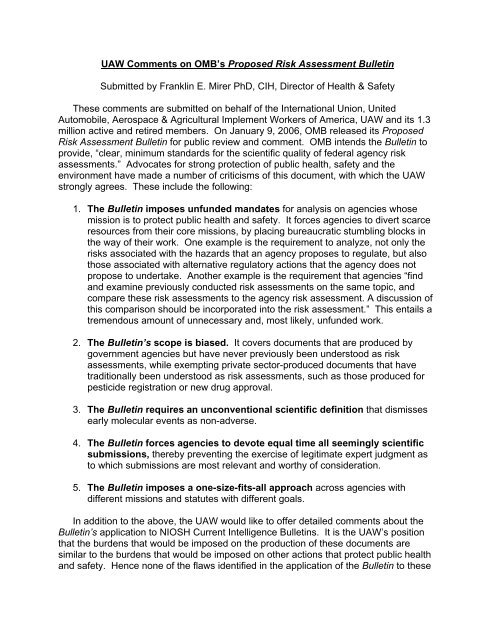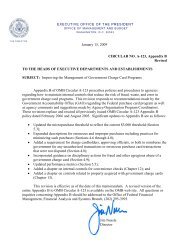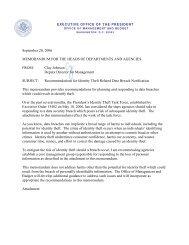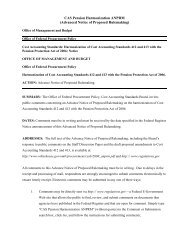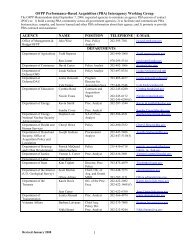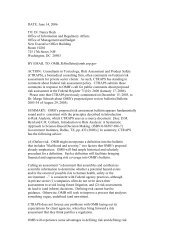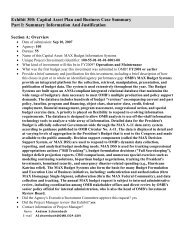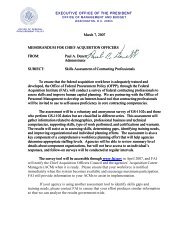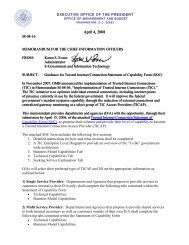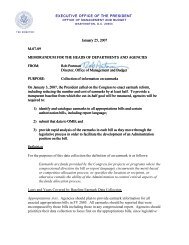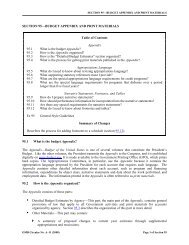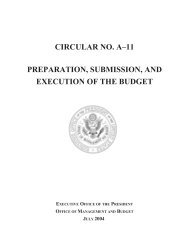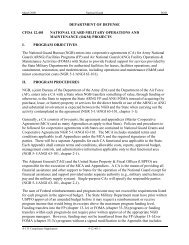Comments on Proposed Risk Assessment Bulletin - The White House
Comments on Proposed Risk Assessment Bulletin - The White House
Comments on Proposed Risk Assessment Bulletin - The White House
Create successful ePaper yourself
Turn your PDF publications into a flip-book with our unique Google optimized e-Paper software.
UAW <str<strong>on</strong>g>Comments</str<strong>on</strong>g> <strong>on</strong> OMB’s <strong>Proposed</strong> <strong>Risk</strong> <strong>Assessment</strong> <strong>Bulletin</strong><br />
Submitted by Franklin E. Mirer PhD, CIH, Director of Health & Safety<br />
<strong>The</strong>se comments are submitted <strong>on</strong> behalf of the Internati<strong>on</strong>al Uni<strong>on</strong>, United<br />
Automobile, Aerospace & Agricultural Implement Workers of America, UAW and its 1.3<br />
milli<strong>on</strong> active and retired members. On January 9, 2006, OMB released its <strong>Proposed</strong><br />
<strong>Risk</strong> <strong>Assessment</strong> <strong>Bulletin</strong> for public review and comment. OMB intends the <strong>Bulletin</strong> to<br />
provide, “clear, minimum standards for the scientific quality of federal agency risk<br />
assessments.” Advocates for str<strong>on</strong>g protecti<strong>on</strong> of public health, safety and the<br />
envir<strong>on</strong>ment have made a number of criticisms of this document, with which the UAW<br />
str<strong>on</strong>gly agrees. <strong>The</strong>se include the following:<br />
1. <strong>The</strong> <strong>Bulletin</strong> imposes unfunded mandates for analysis <strong>on</strong> agencies whose<br />
missi<strong>on</strong> is to protect public health and safety. It forces agencies to divert scarce<br />
resources from their core missi<strong>on</strong>s, by placing bureaucratic stumbling blocks in<br />
the way of their work. One example is the requirement to analyze, not <strong>on</strong>ly the<br />
risks associated with the hazards that an agency proposes to regulate, but also<br />
those associated with alternative regulatory acti<strong>on</strong>s that the agency does not<br />
propose to undertake. Another example is the requirement that agencies “find<br />
and examine previously c<strong>on</strong>ducted risk assessments <strong>on</strong> the same topic, and<br />
compare these risk assessments to the agency risk assessment. A discussi<strong>on</strong> of<br />
this comparis<strong>on</strong> should be incorporated into the risk assessment.” This entails a<br />
tremendous amount of unnecessary and, most likely, unfunded work.<br />
2. <strong>The</strong> <strong>Bulletin</strong>’s scope is biased. It covers documents that are produced by<br />
government agencies but have never previously been understood as risk<br />
assessments, while exempting private sector-produced documents that have<br />
traditi<strong>on</strong>ally been understood as risk assessments, such as those produced for<br />
pesticide registrati<strong>on</strong> or new drug approval.<br />
3. <strong>The</strong> <strong>Bulletin</strong> requires an unc<strong>on</strong>venti<strong>on</strong>al scientific definiti<strong>on</strong> that dismisses<br />
early molecular events as n<strong>on</strong>-adverse.<br />
4. <strong>The</strong> <strong>Bulletin</strong> forces agencies to devote equal time all seemingly scientific<br />
submissi<strong>on</strong>s, thereby preventing the exercise of legitimate expert judgment as<br />
to which submissi<strong>on</strong>s are most relevant and worthy of c<strong>on</strong>siderati<strong>on</strong>.<br />
5. <strong>The</strong> <strong>Bulletin</strong> imposes a <strong>on</strong>e-size-fits-all approach across agencies with<br />
different missi<strong>on</strong>s and statutes with different goals.<br />
In additi<strong>on</strong> to the above, the UAW would like to offer detailed comments about the<br />
<strong>Bulletin</strong>’s applicati<strong>on</strong> to NIOSH Current Intelligence <strong>Bulletin</strong>s. It is the UAW’s positi<strong>on</strong><br />
that the burdens that would be imposed <strong>on</strong> the producti<strong>on</strong> of these documents are<br />
similar to the burdens that would be imposed <strong>on</strong> other acti<strong>on</strong>s that protect public health<br />
and safety. Hence n<strong>on</strong>e of the flaws identified in the applicati<strong>on</strong> of the <strong>Bulletin</strong> to these
NIOSH activities could be resolved simply by exempting them from the reach of the<br />
OMB <strong>Proposed</strong> <strong>Risk</strong> <strong>Assessment</strong> <strong>Bulletin</strong>. For illustrative purposes, these comments<br />
discuss a Current Intelligence <strong>Bulletin</strong> realted to an occupati<strong>on</strong>al hazard that affects our<br />
membership. <strong>The</strong> producti<strong>on</strong> of this Current Intelligence <strong>Bulletin</strong> would have been<br />
unduly burdened had the OMB <strong>Proposed</strong> <strong>Risk</strong> <strong>Assessment</strong> <strong>Bulletin</strong> been in effect at the<br />
time.<br />
Toluene diisocyanate (TDI) is widely used in the manufacture of flexible<br />
polyurethane foams, elastomers, surface coatings, fibers, sealants, and adhesives.<br />
Many of these products are used in the manufacture of automobiles and automobile<br />
parts. As a result, many of our members are exposed to TDI. NIOSH Current<br />
Intelligence <strong>Bulletin</strong> 53: toluene diisocyanate (TDI) and toluenediamine (TDA); evidence<br />
of carcinogenicity was published in 1989 because chr<strong>on</strong>ic toxicity data from animal<br />
studies provided evidence of an associati<strong>on</strong> between cancer and exposure to<br />
commercial-grade TDI (an 80:20 mixture of 2,4- and 2,6-TDI). <strong>The</strong> tumorigenic<br />
resp<strong>on</strong>ses observed in both rats and mice met the criteria of the Occupati<strong>on</strong>al Safety<br />
and Health Administrati<strong>on</strong> (OSHA) Cancer Policy for classifying a substance as a<br />
potential occupati<strong>on</strong>al carcinogen. NIOSH recommended that in the face of this<br />
evidence, it was prudent to c<strong>on</strong>trol exposure to all TDI and TDA isomers as if they were<br />
carcinogens, which meant limiting exposures to the lowest feasible c<strong>on</strong>centrati<strong>on</strong>s.<br />
It is important to note that NIOSH did not assert that there was scientific proof that all<br />
TDI and TDA isomers were carcinogenic. NIOSH however, was sufficiently c<strong>on</strong>cerned<br />
that they might be carcinogenic that the agency believed that warning employers and<br />
practiti<strong>on</strong>ers of occupati<strong>on</strong>al health and safety was the wise course of acti<strong>on</strong>. <strong>The</strong><br />
effect, if not the intent, of the <strong>Proposed</strong> <strong>Risk</strong> <strong>Assessment</strong> <strong>Bulletin</strong> would be to silence all<br />
such wisdom, prudence and comm<strong>on</strong> sense <strong>on</strong> the part of civil servants dedicated to<br />
protecting the public’s health and safety. Even where total silence would be avoided,<br />
there would still be a delay in getting urgent informati<strong>on</strong> to those who need it in order to<br />
protect public health and safety.<br />
NIOSH Current Intelligence <strong>Bulletin</strong> 53 presents major routes of occupati<strong>on</strong>al<br />
exposure to commercial grade TDI, chemical and physical properties, and in vitro<br />
mutagenicity. It has a lengthy discussi<strong>on</strong> of the animal studies that prompted the<br />
publicati<strong>on</strong> and of independent reviews of these studies. Finally, it presents the known<br />
human health effects. If Current Intelligence <strong>Bulletin</strong> 53 were subject to the<br />
requirements of OMB’s <strong>Proposed</strong> <strong>Risk</strong> <strong>Assessment</strong> <strong>Bulletin</strong>, either it would not be<br />
published or it would take c<strong>on</strong>siderably l<strong>on</strong>ger for its recommendati<strong>on</strong>s to reach those<br />
resp<strong>on</strong>sible for protecting workers. This is because, under OMB’s <strong>Bulletin</strong>, NIOSH<br />
would have to add the following:<br />
• a definiti<strong>on</strong> of the relevant exposure scenarios,<br />
• the type of dose-resp<strong>on</strong>se relati<strong>on</strong>ship,<br />
• a specificati<strong>on</strong> of each populati<strong>on</strong> addressed,<br />
• the expected risk or central estimate of risk for the specific populati<strong>on</strong>s,<br />
• each appropriate upper-bound or lower-bound estimate of risk,<br />
• each significant uncertainty identified in the process of the assessment of risk<br />
and the studies that would assist in resolving the uncertainty,
• a discussi<strong>on</strong> regarding the nature, difficulty, feasibility, cost and time associated<br />
with undertaking research to resolve key scientific limitati<strong>on</strong>s and uncertainties,<br />
• peer-reviewed studies that support, are directly relevant to, or fail to support the<br />
estimates of risk,<br />
• the methodology used to rec<strong>on</strong>cile inc<strong>on</strong>sistencies in the scientific data, and<br />
• placement of the risk in c<strong>on</strong>text with other risks familiar to the target audience.<br />
NIOSH would also have been required to make a draft of this document available for<br />
notice and comment and to resp<strong>on</strong>d to all significant comments, including all comments<br />
that claim to be based <strong>on</strong> science. When we remember that the original purpose of this<br />
document was to provide informati<strong>on</strong> in a timely manner to people who are resp<strong>on</strong>sible<br />
for protecting the health and safety of workers, it seems unreas<strong>on</strong>able and<br />
counterproductive that all these requirements should be placed <strong>on</strong> this or any Current<br />
Intelligence <strong>Bulletin</strong>. It seems even more unreas<strong>on</strong>able and counterproductive when we<br />
remember that the Current Intelligence <strong>Bulletin</strong> does not require employers to do<br />
anything nor does NIOSH have the legal authority to promulgate enforceable<br />
regulati<strong>on</strong>s.<br />
One can <strong>on</strong>ly c<strong>on</strong>clude that either OMB is woefully unaware of the practical<br />
c<strong>on</strong>sequences of its own <strong>Proposed</strong> <strong>Risk</strong> <strong>Assessment</strong> <strong>Bulletin</strong> or that it intends to<br />
impede government agencies from providing informati<strong>on</strong> relevant to the public’s health<br />
and safety in a timely manner that will permit its prudent use. Either way, the proposal<br />
that OMB has produced is unc<strong>on</strong>sci<strong>on</strong>ably broad and prescriptive. It will prevent those<br />
government agencies resp<strong>on</strong>sible for protecting health, safety and the envir<strong>on</strong>ment from<br />
carrying out their missi<strong>on</strong>s. This may even be the intent of the proposal. It should be<br />
withdrawn.


